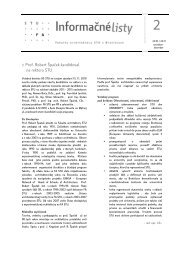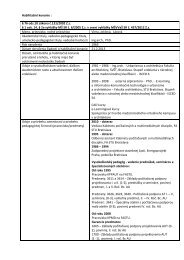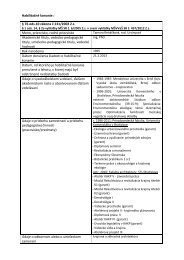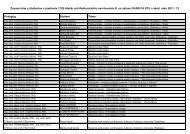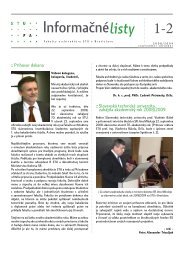ALFA 3-4/2005 - Fakulta architektúry STU
ALFA 3-4/2005 - Fakulta architektúry STU
ALFA 3-4/2005 - Fakulta architektúry STU
You also want an ePaper? Increase the reach of your titles
YUMPU automatically turns print PDFs into web optimized ePapers that Google loves.
Ročník 9<br />
3-4 / <strong>2005</strong> ARCHITEKTONICKÉ LISTY FA <strong>STU</strong><br />
The Bézier curve cannot represent conic curves (a.i. a circle).<br />
A conic curve can be represented using a rational function, which<br />
is defined as a ratio of two polynomials:<br />
According this definition, the rational Bézier curve is defined as<br />
The new variables wi are scalars called weights. The varying<br />
weight value of thr control point will lead to a greater attraction or<br />
repulsion of the curve. The clearest way how to explain this is with<br />
an example. In figure 2, three Bézier curves are drawn with<br />
the only difference in the weight of the control point P2. With<br />
the weight 1.0 the shape of the curve is the same as in figure 1.<br />
The weight of 2 attracts the curve a bit more towards the control<br />
point and the weight 0.5 pushes the curve away from the point.<br />
figure 2<br />
Using only one rational Bézier curve segment for complex shapes<br />
is very difficult. The change in position of any single control point<br />
cause changes in shape in the whole curve (on all control points).<br />
It is very difficult for a user to predict them intuitively. To avoid<br />
these problems a piecewise rational curve is used.<br />
A piecewise Bézier curve or a B-Spline (for Basic Spline) curve is<br />
constructed from several small Bézier curves of low degrees<br />
joined together. They are joint at breakpoints with a certain level<br />
of continuity.<br />
Moving control points will affect only adjacent parts of the curve.<br />
The curve C(t) is defined in t from the interval [0,1] and it is<br />
composed of the segments C i (t), 1 < i < m. The segments are<br />
joined together at the breakpoints t 0 = 0 < t 1 < t 2 …< t i-1 < ti =1.<br />
The smooth transition between two small curves can be defined in<br />
k continuity. The k continuity is achieved by choosing k+1 control<br />
points of the following curve according to the previous one.<br />
The difference between the continuity of the breakpoints of 0 and<br />
1 is shown in figure 3.<br />
- 55 -<br />
figure 3<br />
The control points circled with another circle are control points<br />
which are used by more than one Bézier segment.<br />
Storing this points more than ones is not memory efficient. If<br />
the curve is said to be C1 continuous , then some of the points<br />
inside a Bézier segment are dependent on the position of<br />
the previous points to satisfy the continuity constraint. Storing this<br />
point in memory is not efficient and not necessary.<br />
The B-Spline equation is more memory efficient and also allows<br />
the local control of the curve; i.e. the basis functions are not<br />
defined over [t 0,t m]. Instead, it is constrained to a limited number<br />
of subintervals.<br />
It is defined as<br />
P i are the control points and N i,p are the p th degree B-Spline<br />
functions. The B-spline has breakpoints which are called knots.<br />
A sequence of these knots is called a knot vector and it is defined<br />
as no-decreasing sequences of real numbers.<br />
Only a rational function can represent conic curve, therefore the<br />
B-spline could be generalized to obtain rational representation.<br />
The name of this generalization is Non-Uniform Rational B-Spline<br />
(NURBS) and it is defined as<br />
Conclusion<br />
Reading the philosophical books of Foucault or Deleuze,<br />
theoretical works of architects, or a tutorial of animation software<br />
shows a significant correspondence in using terms as curve or<br />
spline. Apparently the terms from geometry and mathematics are<br />
very important tools for describing a diagram in Foucault’s work.<br />
Comparing the two kinds of mathematic description curves,<br />
the implicit and the parametric, it is evident that the parametric<br />
curve is much more appropriate for visualizing or constructing<br />
a diagram. Considering the evolution of parametric curve forms,



